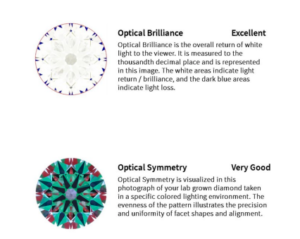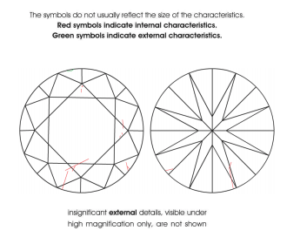
Diamond certificates validate its qualities across the characteristics that most impact the value of a diamond. The average buyer has difficulty distinguishing traits such as cut, color, and clarity, so gemologists from third-party organizations do this work for you.
Two institutions that certify and grade diamonds are the Gem Certification & Assurance Lab (GCAL) and the International Gemological Institute (IGI).
Let’s compare GCAL versus IGI diamonds, including an overview of each lab, how their grades are different, and tips for choosing the right diamond.
What are GCAL Certified Diamonds?
GCAL opened its doors in 2001 and is headquartered in New York City. They’re known for their grading reports and certificates, but they provide a range of services for the jewelry industry such as testing precious metals, inscribing diamonds, and providing educational resources.
For natural diamonds, GCAL has four reports:
- Guarantee Diamond Grading Certificate
- Guaranteed Diamond Grading Certificate with H&A
- Guaranteed Express Grading Certificate
- Diamond Audit Guaranteed Certificate
The one you’ll most commonly see for diamonds sold online or in stores is the Guaranteed Diamond Grading Certificate. It includes much of the same information as reports from other certifying organizations, but let’s explore the details so you know how to interpret it.
The example we’ll use is for this round-cut diamond.

On the left panel is the identifying information.

There’s an image of the laser inscription with its serial number.
To verify the certificate from the vendor is authentic, you can look up the serial number on GCAL’s website here.
I entered “322020092,” and GCAL shows the same report.

On the bottom of the left panel is the proportion diagram.

It provides details on key measurements like its table, width, depth, and girdle thickness.
In the middle section, titled “The 4 Cs Grading Analysis,” you’ll find information on the primary traits that make up the quality of a diamond: carat, cut, color, and clarity.
The carat weight is at the top of GCAL certificates. Below is the diamond’s cut, with the measurements used to determined cut quality such as:
- Shape
- Measurements
- Optical brilliance
- Table percentage
- Depth percentage
Below cut, you’ll find its grades for color and clarity, with additional details in subcategories.
The third section of GCAL certificates details light performance.

Brilliance is a key consideration in the mind of many buyers, so one-third of the report is dedicated to the diamond’s performance in this area.
In this example, it’s an excellent cut diamond, so the optical brilliance earns that mark even though its symmetry is very good.
What are IGI Certified Diamonds?
IGI is headquartered in Antwerp, Belgium and was founded in 1975. Its proximity to where many diamonds are naturally sourced has helped it become a go-to certifier in Asia and Europe. It has 18 labs around the world in places such as New York, Los Angeles, and Italy.
Like its competitors, it’s most known for diamond certifications but also provides research and education for the jewelry industry.
It offers grades for natural diamonds, ones that are lab-grown, and colored diamonds, including a hearts and arrows analysis.
Their standard reports feature much of the same information as you’ll find on GCAL’s. The example we’ll walk through is for this 1.04-carat round cut.
On the left side is the IGI report number, which should match the serial number on the diamond’s girdle.

Verify the report on this page of IGI’s website, so you know the one from the vendor is authentic.
Below the identifying information is the grading results across the four Cs and additional notes on its cut and fluorescence.

The middle panel features the proportions diagram and clarity characteristics plot.

As a helpful reference for buyers, they include clarity and color scales on the reports. So if a diamond is graded an SI1 clarity and K color, you’ll know where on the scale those grades are located.
Like GCAL, IGI stepped in to meet the demand for certificates on lab-grown diamonds.
In fact, IGI claims in 2005, they became the first institute to fully grade lab-grown diamonds. Since then, many others have decided to also grade synthetic gems due to their popularity.
Here’s the IGI certificate for this lab-grown diamond.

Notice how the report goes to great lengths to identify it as lab-grown because that significantly affects its value. I’ve highlighted all those mentions.
Similar to its competitors, IGI allows you to verify their reports by entering the serial number on their website.
How are GCAL and the IGI Different?
GCAL and IGI are competitors, each offering many of the same services. But they have differences in reputation and the way they compile diamonds reports.
Let’s examine four distinctions between GCAL and IGI diamond certifications so you know what to expect as a consumer.
1. IGI Partners with Large Retailers
IGI is known for certifying diamonds for some of the largest jewelry chains in the United States and Canada such as Kay and Zales. If you’re browsing online or at one of their physical locations, they’ll often showcase the accompanying IGI report.

The reason these retailers work with IGI is because of speed and cost. Diamond sellers want to turn over their inventory quickly, and labs such as the Gemological Institute of America (GIA) and American Gem Society (AGS) often don’t process them as quickly.
Additionally, the reputation of those labs allow them to charge a higher price, which can cut into the seller’s margin.
On the other hand, reputable retailers that sell primarily online, such as Brilliant Earth, Clean Origin, Frank Darling, and Blue Nile, promote many of their diamonds as GCAL-certified.
2. IGI Reports Include a Clarity Characteristics Plot
Clarity is an important trait in a diamond because the presence of inclusions diminishes its overall appearance and light performance. As a prospective buyer, you should know what types of inclusions are present and where they’re located.
One way to find this information is through a clarity characteristic plot, also known as an inclusion plot.
On the right side of IGI reports, there’s a diagram of the diamond’s table and pavilion that indicates where inclusions are found. This is helpful because inclusions are often difficult to examine with the naked eye on diamonds graded VS2 or above.

GCAL reports only list the clarity grade, inclusions, and their location. There’s no inclusion plot attached. For example, the clarity grade will be written:
- Clarity: VS2
- Identifying Characteristic(s): feathers, needles, pinpoints
- Characteristics Location(s): Upper girdle, bezel
To learn more, you’ll have to view the diamond in person, often with magnification, or with a high-quality image of the diamond online or on the GCAL certificate.
3. GCAL Offers Guarantees
GCAL offers a guarantee on diamond certificates. They claim they’re the only gemological lab to do so. Others in the industry provide disclaimers that help them avoid liability for errors in their gemologists’ judgements.

There’s a degree of subjectivity in grading a diamond. While carat weight involves placing the diamond on a scale and recording the weight, qualities such as clarity and color are measured on a spectrum.
Even expert gemologists may differ on whether a diamond deserves a VVS1 or VVS2 clarity.
Institutions such as the IGI include both a B2C and B2B terms and conditions document.
For example, its B2C disclaimer says it cannot be held responsible for “any difference or opinion or discrepancy which may result from the application of other grading, assessment and/or identification methods, tools, or techniques.”
It acknowledges the same diamond could be shipped to GCAL and its competitors such as HRD or GIA and receive a different grade.
Including the money-back accuracy guarantee means GCAL’s diamond documents aren’t just reports. They could be considered certificates that guarantee its color and clarity align with international standard grading practices.
4. GCAL Reports Include an Image of the Diamond
In the bottom of the middle panel on a GCAL diamond report, you’ll find an image of the diamond’s crown and pavilion. It’s magnified up to 10x, so it presents a different picture of the diamond than you’d see with the naked eye.

The image is less helpful than what many diamond retailers provide on their website.
James Allen, where I bought my wife’s engagement ring, and other vendors provide high-resolution images of the diamond, so you can know what to expect when it arrives in the mail.
The image of the diamond on GCAL reports doesn’t show inclusions like a clarity plot on IGI reports, but it does give you an idea of its appearance.
How do Their Certificates Impact a Diamond’s Price?
There are two ways diamond certificates from GCAL and IGI impact price. The first is the actual grades given on the certification.
For example, let’s assume a diamond is given the following grades on a certification:
- Carat: 2.00
- Cut: Excellent
- Clarity: VVS1
- Color: D
Another diamond may receive the following grades:
- Carat: 2.00
- Cut: Very good
- Clarity: VS1
- Color: E
All else being equal, the first diamond would sell for a higher price because it was deemed higher quality.
Additionally, the grading institution’s reputation impacts price. Even though they provide many of the same services, some diamond certifiers are considered more credible by the industry and buyers. The GIA and AGS are generally seen as the preeminent organizations.
Buyers are often willing to pay a higher price for a diamond certified by either of those organizations because it gives them confidence in the diamond’s quality.
GCAL and IGI don’t demand the same premium as the GIA and AGS. While a certified diamond will generally cost more than an uncertified diamond if all else is equal, you’ll often pay a lower price for a GCAL or IGI diamond.
It’s not that GCAL or IGI are offering poor assessments of a diamond. Instead, the industry and buyers are willing to pay premiums for GIA and AGS for their long-standing reputations.
Should You Choose a GCAL or IGI Diamond?
Although GCAL and IGI can both provide accurate assessments of a diamond’s qualities, I recommend GCAL and GIA diamonds. If it’s lab-created, both IGI and GCAL are great choices.
Even a one or two grade difference on a diamond’s four Cs can dramatically increase the final cost, so you need a strict grading system that won’t overvalue the diamond.
The best way to find the right diamond for you is to buy from a trusted retailer online or in-person and ensure it has the accompanying certificate.
View it in person or through high-resolution photos.
Every buyer should have confidence in the value of their diamond, and choosing one with a GIA or GCAL report is a helpful step in that direction.

Jacob Clarke
Jacob Clarke is the founder of TeachJewelry.com.
He earned an Applied Jewelry Professional Diploma from the Gemological Institute of America (GIA) and now brings you essential information about diamonds, settings, and more.
Jacob has consulted with leading jewelry brands, and his work has been cited in Clean Origin, Diamond Nexus and industry publications.
He's also a member of the International Gem Society.
He enjoys discussing jewelry with readers, so contact him with any questions at jacob.clarke@teachjewelry.com.













